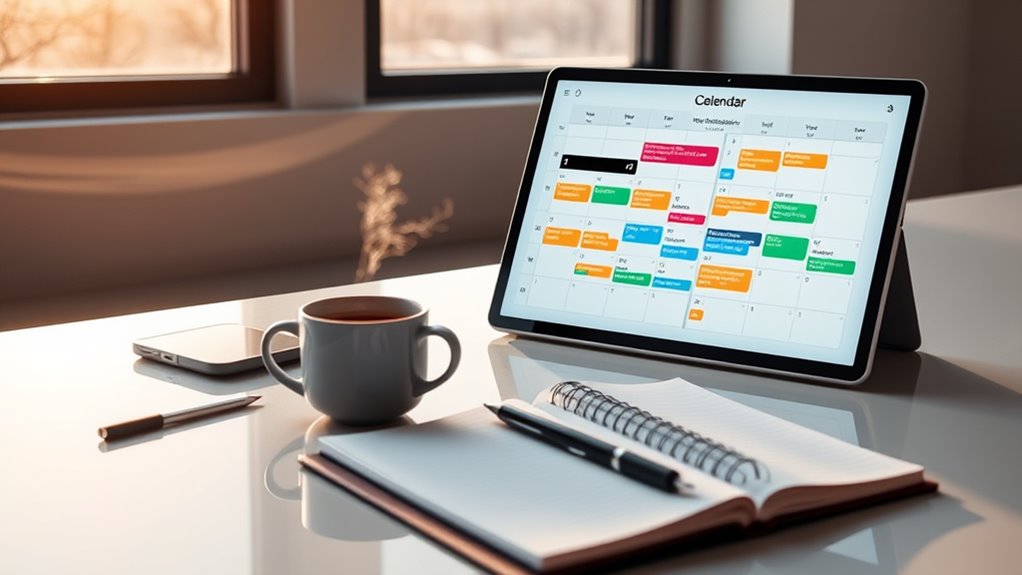Adopting structured calendar routines can save you time by boosting your productivity and reducing decision fatigue. Prioritize urgent and important tasks first, scheduling high-priority activities early in the day. Use digital tools with features like color-coding, reminders, and recurring events to stay organized and flexible for unexpected changes. Regularly reviewing and adjusting your schedule guarantees you stay focused on your goals. Keep exploring ways to optimize your routines for maximum efficiency.
Key Takeaways
- Establish consistent daily routines with recurring calendar events to minimize decision fatigue and streamline tasks.
- Prioritize high-impact tasks and schedule them during peak productivity hours early in the day.
- Use color-coding and reminders to quickly identify and focus on urgent, important activities.
- Allocate buffer times to accommodate unexpected changes and prevent schedule overload.
- Regularly review and adjust your calendar to stay aligned with evolving goals and maintain efficiency.

Establishing a consistent calendar routine can substantially boost your productivity and reduce stress. When you organize your day with clear, recurring habits, you create a framework that helps you stay focused and on track. One of the most effective ways to do this is by mastering task prioritization. You need to identify which tasks are urgent and important, then schedule these first. By blocking out dedicated time for high-priority activities, you prevent less critical tasks from eating into your productive hours. Digital calendar tools make this easier because they allow you to visualize your tasks and deadlines clearly. With features like color-coding, labels, and reminders, you can quickly see what needs your attention and when, ensuring nothing slips through the cracks.
Using digital calendar tools also helps you automate your routine. For example, you can set recurring events for daily meetings, exercise, or breaks. This automation reduces decision fatigue and frees up mental space for more complex tasks. You’re not constantly figuring out what to do next; instead, your calendar guides your day, keeping you aligned with your goals. Additionally, these tools often integrate with task management apps, enabling you to link specific tasks to calendar events. This integration streamlines your workflow, so you’re always aware of upcoming deadlines and can adjust your schedule accordingly.
Automate routines with recurring calendar events and integrated task management for seamless productivity.
Another advantage of digital calendar tools is their flexibility. Life is unpredictable, and your schedule should reflect that. When unexpected tasks or emergencies arise, you can easily reschedule or shift appointments without losing track of your priorities. Many apps also offer notifications and reminders, which help you stay disciplined and punctual. These features are especially useful if you tend to forget or underestimate how long certain activities take. By allocating buffer times between tasks, you prevent your day from becoming overly packed or chaotic. Additionally, understanding the history and cultural significance of routines can motivate you to stick to your schedule, as it highlights the long-standing value of structured habits in human civilization.
Creating a routine isn’t just about setting fixed schedules; it’s about cultivating consistency. When you stick to your calendar routine, you develop habits that reinforce productivity and reduce decision fatigue. Over time, task prioritization becomes second nature, and digital tools support you in maintaining this discipline. The key is to review your calendar regularly, adjust as needed, and stay committed to your schedule. This proactive approach keeps you organized, minimizes stress, and ensures you make the most of your time each day. By leveraging task prioritization strategies and digital calendar tools, you set yourself up for success, transforming your busy days into manageable, efficient routines.
Frequently Asked Questions
How Do I Prioritize Urgent Tasks Effectively?
To prioritize urgent tasks effectively, start by evaluating their importance and deadlines. Use time blocking to dedicate specific periods for these tasks, ensuring they get immediate attention. Incorporate task batching to handle similar urgent tasks together, increasing efficiency. Avoid multitasking and focus solely on high-priority items during your designated blocks. This approach helps you manage urgent tasks promptly without neglecting other responsibilities.
What Tools Best Support Calendar Routine Automation?
You can use calendar apps like Google Calendar or Outlook, which offer built-in automation features such as event reminders and scheduling suggestions. Additionally, automation tools like Zapier or IFTTT integrate with your calendar, streamlining repetitive tasks like booking meetings or sending follow-up emails. These tools help you stay organized effortlessly, saving time and reducing manual effort, so you can focus on more important tasks.
How Can I Adapt Routines During Busy Periods?
When your schedule gets insanely hectic, you can still stay on track by supercharging your routines. Use time blocking to carve out focused chunks of your day, and habit stacking to link new routines with existing ones—like stretching after your morning coffee. This combo helps you adapt seamlessly during busy periods, making your calendar work for you rather than against you, even when chaos reigns.
What Are Common Mistakes in Calendar Planning?
You often make mistakes in calendar planning by neglecting effective time blocking and poorly scheduling meetings. You might overcommit, underestimate how long tasks take, or leave gaps that disrupt your flow. Always prioritize time blocking to allocate dedicated periods for specific tasks, and be mindful when scheduling meetings to avoid overlaps. By improving how you plan and reserve your time, you’ll boost productivity and reduce stress.
How Do I Handle Unexpected Schedule Disruptions?
When unexpected disruptions occur, stay flexible, adapt quickly, and don’t panic. Use flexible scheduling to shift appointments, reschedule tasks, and prioritize what’s urgent. Embrace contingency planning by having backup plans ready, knowing whom to contact, and setting aside buffer time. This way, you maintain control, reduce stress, and keep your day on track, ensuring that disruptions become manageable rather than disruptive.
Conclusion
By implementing these calendar routines, you’ll find more time for what truly matters. Sure, it might feel like a hassle at first, but once they become habits, you’ll wonder how you ever managed without them. Don’t let the idea of sticking to a schedule intimidate you—start small, stay consistent, and watch your productivity soar. Remember, even the busiest people can save time with just a few intentional tweaks. You’ve got this!









